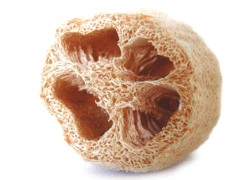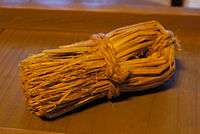Tawashi
A tawashi (たわし or 束子, lit., a bundle) is a scrubbing brush for wet cleaning, of a style that is popular in Japan. Traditionally, tawashis were made of a hemp palm. In Japan, sponges used for rubbing and washing are now treated as forms of tawashi. A metallic tawashi (金属たわし, kinzoku tawashi) is made of metal; steel, stainless steel, and brass are frequent choices. They may be used in removing scorching and rust.
Types
Several synthetic polymers are frequently seen:
- A polyurethane sponge is sometimes called sponge tawashi (スポンジたわし, suponji tawashi).
- Nylon sponges, sometimes called nylon tawashi (ナイロンたわし, nairon tawashi), are suitable for washing tough stains, but should not be used on delicate items.
- An acrylic tawashi (アクリルたわし, akuriru tawashi) is a tawashi made of acrylic, typically knitted or crocheted.
- A luffa sponge, or luffa tawashi (ヘチマたわし, hechima tawashi), is used as a body scrub.
- In recent times, some tawashis are crocheted from cotton yarn, producing the eco-friendly tawashi (エコたわし, eko tawashi), which is scratch-free, and used for dishes and small cleaning jobs. (The prefix eco- (エコ) indicates that it creates less pollution because it can be used without soap or detergents.[1])

A popular Japanese design for a tawashi, said to resemble a young turtle

A yellow polyurethane sponge with a green nylon sponge. It is called sponge tawashi in Japan.

A luffa sponge, called hechima tawashi in Japanese

Tawashi from late Edo period

Screen Tawashi
See also
References
- Ogawa, N. (September 9, 2009). "Magically Clean Eco Tawashi". Craft. 9: 114.
| Wikimedia Commons has media related to Tawashi. |
This article is issued from Wikipedia. The text is licensed under Creative Commons - Attribution - Sharealike. Additional terms may apply for the media files.